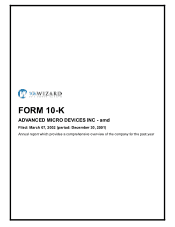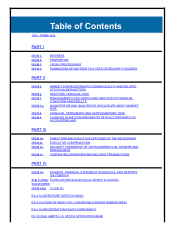AMD 2001 Annual Report Download - page 8
Download and view the complete annual report
Please find page 8 of the 2001 AMD annual report below. You can navigate through the pages in the report by either clicking on the pages listed below, or by using the keyword search tool below to find specific information within the annual report.stored information. The three most significant categories of semiconductor
memory devices are (1) Dynamic Random Access Memory (DRAM) and (2) Static
Random Access Memory (SRAM), both of which are volatile memories, and (3)
non-volatile memory, which includes Flash memory, Read-Only Memory (ROM),
Erasable Programmable Read-Only Memory (EPROM), and Electrically Erasable
Programmable Read-Only Memory (EEPROM) devices.
DRAM provides large capacity main memory, and SRAM provides specialized
high-speed memory. We do not produce any DRAM products, which make up the
largest part of the memory market, or SRAM products.
AMD produces Flash memory devices and EPROM devices. Flash and other
non-volatile memory devices are used in applications in which data must be
retained after power is turned off. Several factors have contributed to an
increasing demand for memory devices in recent years, including the:
. expanding unit sales of PCs in the business and consumer markets;
. increasing use and functionality of cellular phones;
. increasing use of PCs to perform memory-intensive graphics and multimedia
functions;
. volume of memory required to support faster microprocessors;
. proliferation of increasingly complex PC software; and
. increasing performance requirements of workstations, servers and
networking and telecommunications equipment.
Flash memory devices are being utilized for an expanding range of uses.
Flash memory devices have a size and cost advantage over EEPROM devices, which
utilize a larger, more expensive memory cell. Flash memory devices also provide
greater flexibility and ease of use when compared to other non-volatile memory
devices, such as ROM and EPROM, because Flash memory devices can be
electrically rewritten to update parameters or system software; ROM cannot be
rewritten and EPROM requires information to be erased using ultraviolet light
before it can be rewritten. Flash memory devices are used to store control
programs and system-critical data in communication devices such as cellular
telephones and routers, which are devices used to transfer data between local
area networks. Flash memory devices are also used in PC cards, which are
inserted into notebook and subnotebook computers or personal digital assistants
to provide added data storage.
The Logic Market
Logic devices consist of structurally interconnected groupings of simple
logical "AND" and logical "OR" functions, commonly described as "gates."
Typically, complex combinations of individual gates are required to implement
the specialized logic functions required for system applications. The greater
the number of gates on a logic device, the higher that logic device's density
and, in general, device cost (for a particular process and architecture). Logic
devices are generally grouped into five families of products (from lowest
density to highest density):
. standard logic devices;
. programmable logic devices (PLDs);
. conventional gate-arrays;
. standard cells; and
. full custom ICs.
Conventional gate-arrays, standard cells and full-custom ICs are often referred
to as application-specific ICs (ASICs).
4
Source: ADVANCED MICRO DEVIC, 10-K, March 07, 2002





















